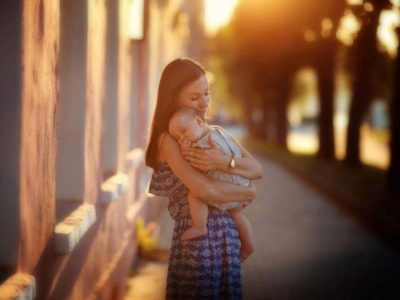In the womb, a mother’s umbilical cord delivers oxygen and nutrients to her unborn child and carries away waste. The cord, which is typically between 18 and 24 inches long and an inch in diameter, functions as a lifeline to the fetus. When the cord is cut at birth, the baby’s physical attachment to the mother ends and the process of psychological attachment to her begins. While the first attachment provides all that is needed to survive inside the womb, the second, according to many psychologists, determines how well the baby functions in the world.
The most important task in the first year of a child’s life is to develop a sense of trust, according to pioneering psychologist John Bowlby, and the parent-infant attachment is the most critical element involved in fostering such development. Bowlby saw an infant and child’s early experiences with primary caregivers as an external model for the child’s internal regulation, with the quality of the attachment reflecting the child’s and later, the adult’s measure of self-control. Bowlby’s main conclusion based on his research was, in essence, to grow up mentally healthy, “the infant and young child should experience a warm, intimate and continuous relationship with his mother or mother substitute, in which both find satisfaction and enjoyment.” Bowlby’s colleague, Mary Ainsworth later developed the methodology used to test Bowlby’s theory and the two collaborated to formulate what would later be known as Attachment Theory. Various researchers in the field have studied the theory over the past several decades and have expanded it to include four types of attachment styles in infants and children that subsequently lead to four types of attachment styles in adults.
Early Attachment Patterns
Secure Attachment:
Children who have experienced emotional attachment to an adult who is consistently attuned, sensitive and responsive to them in their first two years of life are securely attached.
Avoidant Attachment:
Children who have a primary caregiver who is emotionally unavailable, unaware and/or insensitive to their needs, discouraging crying and encouraging independence, will pull away from needing others and develop avoidant attachment with a misattuned parent.
Ambivalent/Anxious Attachment:
Children who experience inconsistent responses from a parent or caregiver who is sometimes nurturing but other times insensitive are confused and insecure, not knowing what type of treatment to expect. They are often suspicious and mistrustful but at the same time clingy and desperate and develop an anxious/ambivalent attachment with their unpredictable parent.
Disorganized Attachment:
When children have an abusive parent, they experience the emotional and physical cruelty and frightening behavior as being life-threatening. Caught in a terrible dilemma, their survival instincts tell them to flee to safety, but safety is the very person who terrifies them. They detach from what is happening and block out the experience. This develops as a disorganized attachment with the fearsome parent.
Adult Attachment Styles
Roughly 60 percent of the population has a secure attachment style, while dismissive avoidant types and anxious preoccupied types each make up roughly 20 percent of the population. Less research and therefore less information exists regarding the fearful-avoidant attachment category, but it is believed to be fairly rare.
Secure Attachment:
People who formed secure attachments in childhood have a strong sense of themselves as adults and desire close relationships with others. They have a secure personality style and are comfortable in their independence as well as in relationships with others.
Dismissive Avoidant Attachment:
Those who’ve experienced avoidant attachments in childhood most likely develop dismissive avoidant attachment patterns as adults. They are loners and often approach relationships and emotions with little regard. When facing a stressful situation, their reaction is to flee or distance themselves. They are inward and isolated and emotionally unavailable to others.
Anxious Preoccupied Attachment:
Children who have an ambivalent/anxious attachment to a parent often develop an anxious preoccupied attachment style as adults. They are self-critical and insecure and seek approval and reassurance, but never overcome their self-doubt. Fear of being rejected leads them to distrust others while simultaneously prompting them to be clingy and overly dependent in their relationships. They are turned against themselves and emotionally desperate in their relationships.
Fearful-Avoidant Attachment:
People who grew up with a disorganized attachment often develop fearful-avoidant patterns of attachment. As children, they detached from their feelings during times of trauma, and as adults, they continue to be somewhat detached from themselves. They desire relationships and operate fairly well in them until the relationship progresses to a certain level of intimacy, at which point they regress in time and experience old traumas as if they are happening in the present. They have neither a clear sense of themselves, nor a clear connection with others.
An insecure attachment pattern is a daunting challenge to overcome on its own, or when a person is in a relationship with someone securely attached, but even more so when both partners in a relationship are insecurely attached. A large number of studies have shown that insecurely attached people tend to seek out and attract other insecurely attached people and what’s more, those whose attachment style is the very opposite of their own. This combination will often draw each partner’s limitations into a harsh and unflattering light. One such pairing, the most common type of relationship involving two insecurely attached partners, is the anxious-avoidant relationship.
This relationship pattern plays out because a person with an anxious-preoccupied attachment style is overly self-critical and in constant need of reassurance. The reassurance never quite makes a difference, however, and the anxious partner is therefore always in need of more. An anxiously attached person believes that constant connection and reassurance are required in order to be close to someone, but at the same time, does not deem him or herself worthy of such closeness. A relationship with an avoidant type provides validation of this belief.
In turn, the avoidant type wants to feel superior in a relationship and to appear to be above needing others. Pairing with an anxious-preoccupied type serves both of those needs because the avoidant type can rest assured the anxious partner will be overly possessive and demanding of attention, thus making it unnecessary to risk anything, while at the same time allowing him or her to feel superior to the anxious partner for such behavior. When, after a period, one or both partners grow disenchanted and dissatisfied and the relationship ends, the avoidant type, in turn, finds validation in the idea that it’s best to rely on oneself and avoid the disappointment involved in the inevitable break-up.
This type of relationship, while not necessarily doomed, is one fraught with dissatisfaction and push and pull cycles that eventually wear down one or both partners unless awareness of the dynamic exists, as well as the desire by both people in the relationship to better understand and meet their partner’s needs, as well as their own.
Ultimately, while we are each bound to bear a little damage and a little baggage from our infancy and childhood – and oftentimes more than a little – it’s an important comfort that most of us will nonetheless survive. What’s more, with awareness and an open-minded approach coupled with necessary resolve, it is possible to minimize the damage carried over into our adult relationships and most importantly, avoid passing our insecure attachment patterns to our children.
To determine your own particular attachment style, take this quiz.


